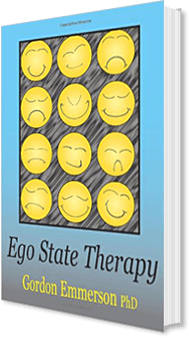
Ego State Therapy
Overview
Mastering the subject of ego state therapy can help answer such questions as "What creates the words we hear in our mind?" or "What internal system produces depression, panic attacks, and addiction?" Emmerson's innovative book presents the theory and practice of working with ego states, helping to understand them, recognize and use them.
Working directly with the ego state that needs assistance provides the shortest distance between the goal and the solution.
The practical techniques described will help you to locate ego states in pain, trauma, anger, or frustration and facilitate expression, release, comfort, and empowerment.
Product Details
| ISBN | 978-184-5900-79-3 |
| Publisher | Crown House Publishing |
| Format | Paperback |
| Author | Gordon Emmerson, PhD |
| Dimensions | 9.13 (h) x 6.18 (w) x 0.5 (d) inches |
| Pages | 212 |
| Weight | 370 grammes |
Contents
Introduction
- Turning the lights on : Ego state therapy
- Goals of ego state therapy
- Benefits
Chapter 1 : What are ego states and how did we learn about them?
- Ego States
- The nature of ego states
- Development and permanence of ego states
- Introjects
- Nature of an introject
- Inner strength
- Nature of inner strength
- Ego states and physiology
- Ego states and psychology
- Beginnings
- Efficacy
- Related therapies
- Psychoanalysis
- Gestalt therapy
- Transactional analysis
- Other therapies
Chapter 2 : Accessing ego states in therapy
- Non-hypnotic access
- Empty chair technique
- Conversational technique
- Hypnotic access
- Hypnosis
- General guidelines for talking with ego states
- The dichotomous technique for accessing ego states
- The resistance deepening technique
- The resistance bridge technique
- Accessing states that are reluctant to speak
Chapter 3 : Using ego states in therapy
- Processing trauma
- Abreactions
- Neurotic reactions
- Finding the trauma
- Tools for processing trauma
- When is processing complete?
- Improving ego state communication
- Negotiating among ego states
- Encouraging states into alternate roles
- Working with difficult and malevolent ego states
- When is ego state communication good enough?
- Gaining personal awareness of ego states
- Ego state mapping
- Advantages of knowing your states
- Personal development with ego state therapy
- Self talk for health : experiencing better physical health
- How many states to know?
Chapter 4 : Application of ego state therapy
- Alleviating psychosomatic symptoms
- Ego state therapy in the control of pain
- Couples counseling
- Bringing relationships to a higher level : The enhanced relationship
- Reducing depression and anger
- Depression
- Anger
- Panic attacks
- Panic attacks steamming from unresolved trauma
- Panic attacks steamming from residuals of non-assertive behavior
- Talking with a person who is having a panic attack
- Ego state therapy in the treatment of addictions
- Drug addiction
- Smoking cessation and diet control
- Multiple personality (Dissociative identity disorder)
- Post traumatic stress disorder (PTSD)
Chapter 5 : The ego state session
- Components of an ego state therapy session
- A session to resolve trauma
- A session to enhance internal communication
- A session to promote self awareness and knowledge of strengths
Chapter 6 : Final thoughts
- Why ego state therapy?
- Theoretical implications of ego state theory
- Blocked and false memories
- Nature/nurtune
- Conclusion